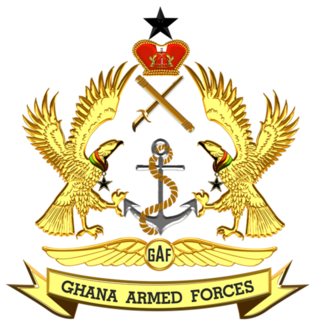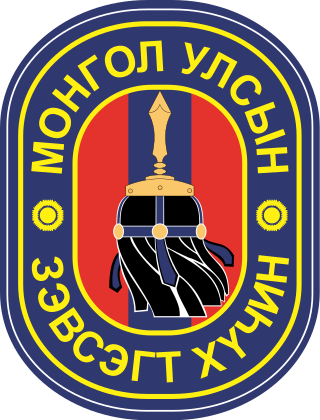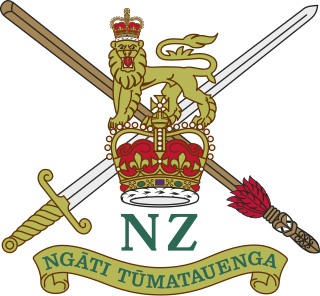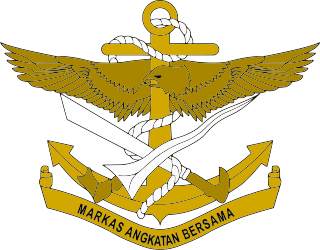
The Ghana Armed Forces (GAF) is the state military organisation of Ghana, consisting of the Army (GA), Navy (GN), and Ghana Air Force.

The Italian Armed Forces encompass the Italian Army, the Italian Navy and the Italian Air Force. A fourth branch of the armed forces, known as the Carabinieri, take on the role as the nation's military police and are also involved in missions and operations abroad as a combat force. Despite not being a branch of the armed forces, the Guardia di Finanza is organized along military lines. These five forces comprise a total of 340,885 men and women with the official status of active military personnel, of which 167,057 are in the Army, Navy and Air Force. The President of the Italian Republic heads the armed forces as the President of the High Council of Defence established by article 87 of the Constitution of Italy. According to article 78, the Parliament has the authority to declare a state of war and vest the powers to lead the war in the Government.

The Mongolian Armed Forces is the collective name for the Mongolian military and the joint forces that comprise it. It is tasked with protecting the independence, sovereignty, and territorial integrity of Mongolia. Defined as the peacetime configuration, its current structure consists of five branches: the Mongolian Ground Force, Mongolian Air Force, Construction and Engineering Forces, cyber security, and special forces. In case of a war situation, the Border Troops, Internal Troops, Judicial enforcement agency and National Emergency Management Agency can be reorganized into the armed forces structure. The General Staff of the Mongolian Armed Forces is the highest professional military management organization of the state military organization and operates independently from the Ministry of Defense, its government controlled parent body. Mongolian military day is celebrated on 18 March, similar to Defender of the Fatherland Day in Russia and PLA Day in China.

The Netherlands Armed Forces are the military forces of the Kingdom of the Netherlands. The armed forces consist of four service branches: the Royal Netherlands Navy, the Royal Netherlands Army, the Royal Netherlands Air Force and the Royal Netherlands Marechaussee. The service branches are supplemented by various joint support organizations. In addition, local conscript forces exist on the Dutch Caribbean islands of Aruba and Curaçao. These operate under the auspices of the Royal Netherlands Navy and the Netherlands Marine Corps. The armed forces are part of the Ministry of Defence.

His Majesty's Armed Forces (HMAF) is the military of Tonga. It is composed of three operational components and two support elements.

The Canadian Armed Forces are the unified military forces of Canada, including land, sea, and air commands referred to as the Canadian Army, Royal Canadian Navy and the Royal Canadian Air Force. Under the National Defence Act, the Canadian Armed Forces are an entity separate and distinct from the Department of National Defence, which also exists as the civilian support system for the forces.

Military police (MP) are law enforcement agencies connected with, or part of, the military of a state. In wartime operations, the military police may support the main fighting force with force protection, convoy security, screening, rear reconnaissance, logistic traffic management, counterinsurgency, and detainee handling.

The 1st New Zealand Special Air Service Regiment, abbreviated as 1 NZSAS Regt, is the special forces unit of the New Zealand Army, closely modelled on the British Special Air Service (SAS). It was formed on 7 July 1955. It traces its origins to the Second World War and the famous Long Range Desert Group that New Zealanders served with.

The Singapore Armed Forces (SAF) are the military of the Republic of Singapore, responsible for protecting and defending the security interests and the sovereignty of the country. A component of the Ministry of Defence (MINDEF), the armed forces have four service branches: the Army, Navy, Air Force, and Digital and Intelligence Service. An integrated force, it is one of the most capable, robust, technologically sophisticated and powerful militaries in the Southeast Asia region. The SAF is headed by the chief of defence force, appointed by the President, on the advice of the Cabinet.

The Singapore Army is the land service branch of the Singapore Armed Forces (SAF). The largest of the four branches of the SAF, the Singapore Army traces its origins to the 1st Battalion, Singapore Infantry Regiment, which was formed in 1957, when Singapore was still under British colonial rule. After Singapore's independence on 9 August 1965, the Singapore Army Bill was passed in Parliament on 23 December 1965, and National Service (NS) was subsequently introduced in 1967. Mostly made up of conscripts, the Singapore Army can mobilise all operationally-ready military reservists in the event of war or national exigencies.

The New Zealand Army is the principal land warfare force of New Zealand, a component of the New Zealand Defence Force alongside the Royal New Zealand Navy and the Royal New Zealand Air Force.

The United Nations Mission in Liberia (UNMIL) was a United Nations peacekeeping operation established in September 2003 to monitor a ceasefire agreement in Liberia following the resignation of President Charles Taylor and the conclusion of the Second Liberian Civil War (1999–2003). At its peak it consisted of up to 15,000 UN military personnel and 1,115 police officers, along with civilian political advisors and aid workers.

Women in combat refers to female military personnel assigned to combat positions. The role of women in the military has varied across the world’s major countries throughout history with several views for and against women in combat. Over time countries have generally become more accepting of women fulfilling combat roles.

This article is about women in warfare and the military (2000–present) throughout the world outside the United States. For women in warfare and the military in the United States since 2000, please see: Timeline of women in warfare and the military in the United States, 2000–2010 and Timeline of women in warfare and the military in the United States, 2011–present.

The Royal Thai Marine Corps or RTMC are the marines of the Royal Thai Navy. The Royal Thai Marine Corps was founded in 1932, when the first battalion was formed with the assistance of the United States Marine Corps. It was expanded to a regiment in 1940 and was in action against communist guerrillas throughout the 1950s and 1960s. During the 1960s the United States Marine Corps assisted in its expansion into a brigade. The Royal Thai Marine Corps saw action on the Malaysian border in the 1970s, and has now been increased to four brigades.
Train Advise Assist Command – East was a multinational military formation, part of NATO's Resolute Support Mission within Afghanistan. Until 2014 it was designated Regional Command East, part of the International Security Assistance Force (ISAF). The United States Army provided the force headquarters. The command headquarters was located in Laghman Province.

Troops began wearing berets as a part of the headgear of military uniforms in some European countries during the 19th century; since the mid-20th century, they have become a component of the uniforms of many armed forces throughout the world. Military berets are usually pushed to the right to free the shoulder that bears the rifle on most soldiers, but the armies of some countries, mostly within Europe, South America, and Asia, have influenced the push to the left.

The recent history of changes in women's roles includes having women in the military. Every country in the world permits the participation of women in the military, in one form or another. In 2018, only two countries conscripted women and men on the same formal conditions: Norway and Sweden. A few other countries have laws conscripting women into their armed forces, however with some difference such as service exemptions, length of service, and more. Some countries do not have conscription, but men and women may serve on a voluntary basis under equal conditions. Alenka Ermenc was the first female head of armed forces in any of the NATO member states, having served as the Chief of the General Staff of the Slovenian Armed Forces between 2018 and 2020.

The Joint Forces Headquarters is a joint military command which specifically formed to command all tasks of the Malaysian Armed Forces joint operations. The Joint Operations are other operations performed by at least three services such as Malaysian Army, Royal Malaysian Navy and the Royal Malaysian Air Force.

Sheikh Mohamed bin Zayed Rapid Intervention / High Readiness Brigade, also known as Mohamed bin Zayed Quick Reaction Force (MbZ QRF) (Arabic: لواء سمو الشيخ محمد بن زايد ال نهيان/التدخل السريع) is a rapid reaction force of the Jordanian Army, part of the Jordanian Armed Forces (JAF).


















